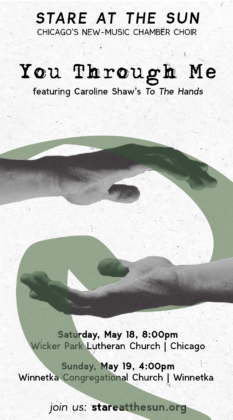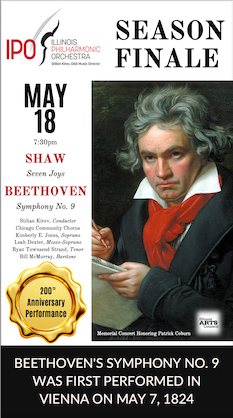Performances
Rattle, Bavarian Symphony deliver a brilliant, devastating Mahler tragedy
It’s been 15 years since Sir Simon Rattle last visited Chicago […]
Bella Voce brings fascinating early rarities out of the shadows
Every so often, Bella Voce takes a deep dive into worthy […]
Isidore Quartet makes impressive Chicago debut at Mandel Hall
The Isidore String Quartet has made local suburban appearances in its […]
Articles
Klaus Mäkelä to become CSO music director—in 2027
The expected news was finally made official Tuesday morning: Klaus Mäkelä […]
Concert review
Third Coast Percussion puts on spectacle with Montgomery, She-e Wu

Third Coast Percussion’s concert on Friday night at DePaul University’s Holtschneider Performance Center demonstrated again why live performance is so vital. Only in person is it possible to feel the energy sizzling between the members of TCP as they bring to life such rhythmically and texturally complex music. Particularly in an age where computer-generated beats are ubiquitous, it is easy to take for granted the amount of communication, concentration, and physicality required to achieve their level of precision and artistry.
Even more than for traditional chamber groups, there is a visual dimension to TCP’s performances as you watch them change instruments and mallets as deftly as dancers. You can see how the unusual sounds are created, which might not be readily apparent without a visual clue. Trying to count the number of instruments on stage Friday night would have been fruitless, but suffice it to say TCP’s extensive setup included flowerpots, Almglocken (tuned cowbells), Tibetan singing bowls, and tom drums with breathing tubes (more on that later).
TCP’s varied programming dispelled any fears that a percussion concert might become monotonous. Half of the works on the program were originally written for other instruments and artfully arranged for percussion quartet by members of TCP. As such, most of the pieces relied heavily on mallet percussion instruments like marimba, vibraphone, and xylophone. Arrangements included Tigran Hamasyan’s playful Étude No. 1, originally for solo piano, and three movements from Philip Glass’s Aguas da Amazonia.
Glass’s minimalist music lends itself naturally to percussion arrangement with its repetitive structures. That said, TCP’s inventive use of different instruments, as well as their impressive dynamic control, prevented the music from ever becoming tedious. Judicious use of electronic tracks supplemented the acoustic instruments on stage. For instance, a subtle bed of synth organ sound added a unique color to “Madeira River” without being overpowering.
Rubix, which TCP wrote in collaboration with the duo Flutronix, made further use of electronic tracks. Because Flutronix were not present at the concert, their flute playing was piped in, adding another layer of coordination complexity. The second movement, “Go,” distinguished itself in its hip-hop feel, achieved through the use of the drum kit and the flutes mimicking rapping with repetitive two-note figures.
The second half of the program highlighted composer and violinist Jessie Montgomery, a fixture of new music in Chicago who is currently wrapping up her final season as the Chicago Symphony Orchestra’s Mead Composer-in-Residence. Montgomery’s Suite from In Color, arranged by TCP member Sean Conners, elicited even more unusual sound combinations, such as whistling, which created otherworldly overtone clashes with the instruments.
Next was Study No. 1, Montgomery’s first piece written expressly for percussion quartet. Featuring mostly unpitched percussion, it made for a welcome change of pace. The piece began with the quartet on a set of tom drums hooked up with air hoses. The players then blew into the hoses to change the pressure inside the drums and the pitch along with it. This bit of physics magic created the effect of a brewing thunderstorm or heavy wind.
The meat of the program was Lou Harrison’s Concerto for Violin with Percussion Orchestra, which brought guest percussionist She-e Wu and Montgomery, now as violin soloist, to the stage. Harrison was among the first generation of classical composers to write for percussion ensemble. Although this piece used the most unusual instruments on the program—such as flowerpots, wind chimes, and cowbells—the solo violin rooted it within the classical tradition. The influence of Shostakovich and Bartók was apparent in the violin part, evoking the image of a time traveler from the Old World thrust into the cacophony of contemporary life.
Montgomery was a serene presence amid the flurry of percussive punctuations and complex rhythms around her. While the first movement featured devilish double stops in the unaccompanied cadenza, her most compelling playing came in the highly exposed slow movement, essentially a violin soliloquy with minimal percussive interference. Montgomery played the slow-winding stream of even quarter notes with supreme legato and subtle phrasing before fading into nothingness. Finally, the return of the bevy of complex percussion led the third movement to a thrilling close.
Third Coast Percussion presents its annual Currents concert, featuring world premieres by St. Julien, Srayamurtikanti, and Zoulek, at Constellation 8:30 p.m. June 21. thirdcoastpercussion.com
Posted in Performances
No Comments
Calendar
May 5
Apollo Chorus
Pierre-Fabien Roubaty, conductor
“A French Festival”
[…]
News
Sir Andrew Davis 1944-2024
Sir Andrew Davis, longtime music director of the Lyric Opera of […]





